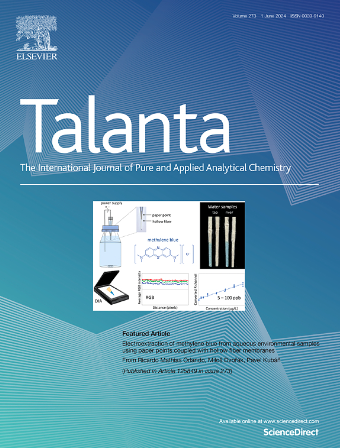Analysis of volatile organic compounds (VOCs) in e-cigarettes: A thermal desorption coupled with gas chromatography-mass spectrometry (TD-GC-MS) approach
IF 5.6
1区 化学
Q1 CHEMISTRY, ANALYTICAL
引用次数: 0
Abstract
This study investigates 67 volatile organic compounds (VOCs) in exhaled e-cigarette aerosol using thermal desorption coupled with gas chromatography-mass spectrometry (TD-GC-MS). As e-cigarettes become increasingly popular as an alternative to traditional smoking, it is essential to understand the chemical composition of their emitted aerosol and their potential health and environmental impacts. The methods employed were optimized and validated, demonstrating high accuracy, excellent linearity, and robust detection limits. The analytical range extended from 0.5 to 25 ng in tube, with detection limits between 0.08 and 0.33 ng in tube and quantification limits from 0.12 to 0.50 ng in tube. Linearity was confirmed with R2 values surpassing 0.9900 for calibration curves. Recovery rates ranged from 88 % to 109 %, and coefficients of variation were between 2 % and 13 %. Twenty-one e-liquid samples were obtained from liquor stores in Belo Horizonte, Brazil, featuring fruity flavors (e.g., watermelon, apple, mint, vanilla, strawberry, pineapple, mango) and three brands. A total of 28 VOCs were identified and quantified, including regulated substances such as BTEX (0.55–9.50 ng in tube or 0.28–4.75 ng mL−1), acetone (0.55–0.86 ng in tube or 0.28–0.43 ng mL−1), and Chlorinated organic pollutants. The TD-GC-MS method proves effective for VOCs analysis in e-cigarettes, providing valuable insights for future research and regulatory efforts.

电子烟中挥发性有机化合物(VOCs)的分析:热脱附-气相色谱-质谱(TD-GC-MS)方法
本研究采用热解吸-气相色谱-质谱联用技术对电子烟气溶胶中67种挥发性有机化合物(VOCs)进行了研究。随着电子烟作为传统吸烟的替代品越来越受欢迎,了解其排放的气溶胶的化学成分及其潜在的健康和环境影响至关重要。对所采用的方法进行了优化和验证,具有较高的准确度、良好的线性度和良好的检出限。分析范围为0.5 ~ 25 ng,检出限为0.08 ~ 0.33 ng,定量限为0.12 ~ 0.50 ng。线性关系证实,R2值大于0.9900。回收率为88% ~ 109%,变异系数为2% ~ 13%。从巴西贝洛奥里藏特的酒类商店获得了21份电子烟液样品,其中包括西瓜、苹果、薄荷、香草、草莓、菠萝、芒果等三个品牌的水果口味。共鉴定和量化了28种VOCs,包括BTEX (0.55-9.50 ng /管或0.28-4.75 ng mL - 1)、丙酮(0.55-0.86 ng /管或0.28-0.43 ng mL - 1)和氯化有机污染物等受管制物质。事实证明,TD-GC-MS方法对电子烟中挥发性有机化合物的分析是有效的,为未来的研究和监管工作提供了有价值的见解。
本文章由计算机程序翻译,如有差异,请以英文原文为准。
求助全文
约1分钟内获得全文
求助全文
来源期刊

Talanta
化学-分析化学
CiteScore
12.30
自引率
4.90%
发文量
861
审稿时长
29 days
期刊介绍:
Talanta provides a forum for the publication of original research papers, short communications, and critical reviews in all branches of pure and applied analytical chemistry. Papers are evaluated based on established guidelines, including the fundamental nature of the study, scientific novelty, substantial improvement or advantage over existing technology or methods, and demonstrated analytical applicability. Original research papers on fundamental studies, and on novel sensor and instrumentation developments, are encouraged. Novel or improved applications in areas such as clinical and biological chemistry, environmental analysis, geochemistry, materials science and engineering, and analytical platforms for omics development are welcome.
Analytical performance of methods should be determined, including interference and matrix effects, and methods should be validated by comparison with a standard method, or analysis of a certified reference material. Simple spiking recoveries may not be sufficient. The developed method should especially comprise information on selectivity, sensitivity, detection limits, accuracy, and reliability. However, applying official validation or robustness studies to a routine method or technique does not necessarily constitute novelty. Proper statistical treatment of the data should be provided. Relevant literature should be cited, including related publications by the authors, and authors should discuss how their proposed methodology compares with previously reported methods.
 求助内容:
求助内容: 应助结果提醒方式:
应助结果提醒方式:


